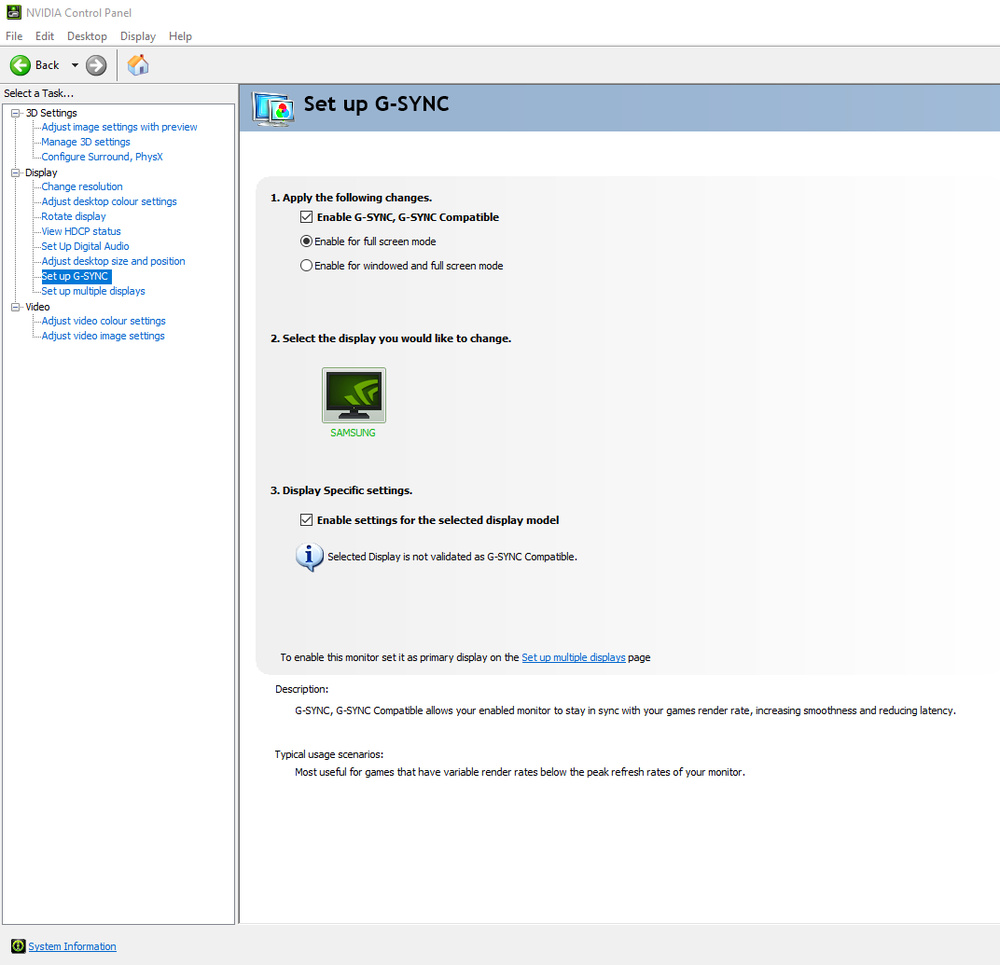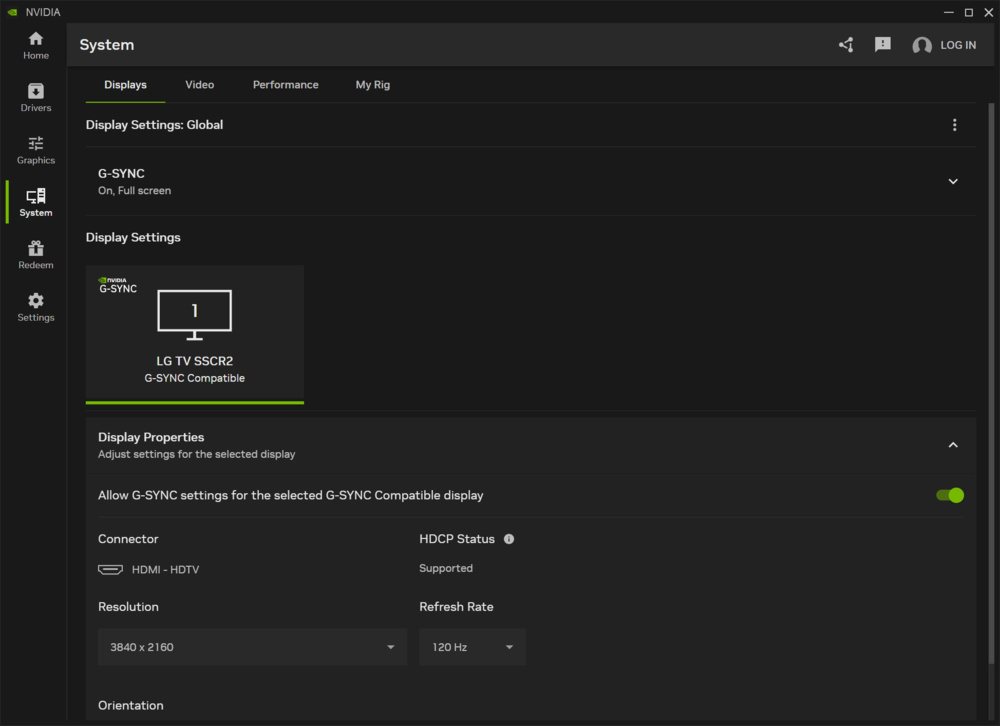- 75.0%4k VRR Maximum
- 25.0%1080p VRR Maximum
Variable Refresh Rate (VRR) technology is a feature in some monitors and TVs that dynamically adjusts the display's refresh rate to match the frame rate of the source signal. This is especially helpful for gamers, as it reduces screen tearing when game frame rates fluctuate. While VRR used to be limited to high-end TVs, it has now become standard in mid-range models and is even starting to appear in some low-end TVs. To test for VRR support, we use different PCs to determine which formats the TV supports and to find the range in which VRR operates.
Test results
Test Methodology Coverage
We last updated this test methodology in our 1.9 test bench, and it also applies to 1.10 and 1.11. TVs tested before version 1.9 didn't include the VRR + Local Dimming test and had a "VRR Supported Connectors" box, which we removed because TVs only support HDMI, so it wasn't relevant. Our latest results are still compatible with reviews that used the older methodology. To learn more, see how our test benches and scoring system work.
| 1.6 | 1.7 | 1.8 | 1.9 | 1.10 | 1.11 | |
|---|---|---|---|---|---|---|
| VRR Supported Connectors | ✅ | ✅ | ✅ | ❌ | ❌ | ❌ |
| VRR + Local Dimming | ❌ | ❌ | ❌ | ✅ | ✅ | ✅ |
When It Matters
Variable Refresh Rate (VRR) support is especially important for gamers. To function properly, both the source (console, PC, etc.) and the TV must support the same VRR format. With VRR, the TV adjusts its refresh rate to match the game's frame rate, even if the game's performance drops. Most PC games and graphics cards, as well as the Xbox X|S and PS5 consoles, already support VRR. Consequently, VRR-compatible TVs are highly beneficial for most gamers.
Without VRR support, screen tearing can occur, creating horizontal lines as if the image is split in two. Even with VRR, some tearing may still happen, but it is significantly reduced compared to displays without this feature.
Our Tests
We begin by confirming which resolutions a TV supports so we know which ones to test for VRR. Although marketing materials often indicate whether a TV supports VRR and which formats it's compatible with, we always verify this ourselves. To test Adaptive Sync, we use a custom-built PC equipped with both an NVIDIA RTX-series graphics card and another one with a recent AMD Radeon GPU. We run an RTINGS-specific version of SmoothFrog to detect issues like screen tearing, stuttering, blanking, and any other artifacts. We disable V-SYNC to ensure the display is actually adjusting its refresh rate to match the source content rather than relying on software-based synchronization. We also test VRR performance on the PlayStation 5 and Xbox Series X|S to capture any console-specific quirks.
Native Refresh Rate
Before performing any VRR tests, we list the native refresh rate of the TV, which we find out by using the supported resolutions test. Currently, the native refresh rate of TVs is always either 60Hz, 120Hz, or 144Hz.
Variable Refresh Rate
This result simply indicates whether the TV supports any form of VRR technology. We test for HDMI Forum VRR, FreeSync, and G-SYNC compatibility. If the TV supports at least one of these three formats, it passes the test and receives a "Yes"; otherwise, it receives a "No."
HDMI Forum VRR
HDMI Forum VRR is primarily a console-oriented VRR format used over HDMI connections, though modern PC graphics cards also support it. The Xbox Series X|S supports HDMI Forum VRR, and the PlayStation 5 has offered support since a firmware update in April 2022. Because the PS5 only supports HDMI Forum VRR, it's straightforward to check if the TV is HDMI Forum VRR compatible when using that console. In contrast, the Xbox Series X|S supports both FreeSync and HDMI Forum VRR, so it can be harder to tell which format is active unless the TV's interface provides a toggle or clear indication.
FreeSync
FreeSync is AMD's implementation of VRR and is widely supported across both TVs and monitors. We test FreeSync using a recent Radeon GPU, which supports FreeSync and HDMI Forum VRR. We open the Radeon Settings on our PC to see if FreeSync can be enabled. Unlike with monitors, we don't check whether the TV is officially certified by AMD; we simply mark "Yes" if FreeSync is functional.
G-SYNC Compatible
The last of the three VRR formats we check is NVIDIA's G-SYNC, and we use our NVIDIA RTX graphics card for this. G-SYNC support is rarer on TVs than on monitors, and TVs with G-SYNC are only certified to be G-SYNC compatible instead of native G-SYNC. Still, G-SYNC-compatible works like native G-SYNC support on TVs, with a more restricted set of features.
We check for G-SYNC compatibility by opening the NVIDIA Control Panel on the RTX PC. We know it supports G-SYNC when there's a 'Set up G-SYNC' option in the left-hand-side column.

If you're using the newer NVIDIA app, the option is under the System/Displays menu.

Finally, we assign a result based on how well the TV supports NVIDIA's Adaptive Sync implementation:
- Yes, NVIDIA Certified: This rating applies to TVs that NVIDIA has officially certified as G-SYNC Compatible.
- Yes: We confirm that these TVs support Adaptive Sync with no major issues, although they aren't NVIDIA-certified.
- No: These displays either don't support Adaptive Sync or become unusable when G-SYNC is enabled.
VRR Maximum
Once we confirm whether the TV supports G-SYNC, we use a PC with an NVIDIA RTX graphics card and an RTINGS-specific version of SmoothFrog to determine the VRR range. If the TV doesn't support G-SYNC, we switch to a Radeon-based PC for testing. With V-SYNC disabled, we open the test software, set our target resolution (e.g., 4K or 1080p), and choose a frame rate that should theoretically be tear-free—typically 55 fps. We then gradually increase the frame rate while matching the TV's refresh rate, watching for any tearing. In most cases, the TV's maximum VRR range matches its highest possible refresh rate.
We repeat the same procedure at both 4K and 1080p. Some TVs without full HDMI 2.1 bandwidth may support a wider VRR range at lower resolutions. Older models often cap the refresh rate at 60Hz when running 4K signals but can sometimes reach 120Hz at 1080p.
VRR Minimum
We follow the same procedure to determine the VRR minimum range, this time by lowering the frame rate. Some TVs employ Low Framerate Compensation (LFC), allowing their VRR minimum to drop below 40 fps. If a TV goes under 20 fps—the lowest setting our tool supports—we list its minimum VRR as "<20Hz." Other TVs may have a VRR lower limit of 40Hz or 48Hz.
We repeat this test with both 4K and 1080p signals.
VRR + Local Dimming
We also check whether the TV can enable local dimming while VRR is active. Although most TVs that have both features do support them at the same time, there are exceptions—such as the Panasonic W95A and Hisense U6/U6K—which cannot. If the TV supports both simultaneously, we mark it as "Yes"; if not, we mark it as "No."
Additional Information
VRR technologies aren't perfect; they don't eliminate all screen tearing and can sometimes increase input lag. However, they're still a useful tool for gamers who notice screen tearing, as they aim to provide a tear-free gaming experience. G-SYNC, HDMI Forum VRR, and FreeSync may be the most well-known VRR technologies, but there are others like VESA Adaptive Sync and mobile VRR. We primarily focus on testing the three main formats.
How To Get the Best Results
To fully benefit from VRR on your TV, make sure your console or PC supports the same VRR format(s) your TV does. For example, you can't use G-SYNC with an NVIDIA graphics card if your TV doesn't support it. You'll often need to enable specific settings on your TV, such as 'Game Mode' or 'Variable Refresh Rate.' Different brands use different names, so refer to the settings pages in our reviews for instructions on how to enable VRR.
Conclusion
Variable refresh rate is a feature that lets the TV adjust its refresh rate on the fly to match the frame rate being sent by the source rather than sticking to a fixed refresh rate. This helps reduce screen tearing. We test each TV's VRR support, including the maximum and minimum frequencies at which it can stay synchronized without tearing. To avoid frame skipping or screen tearing while gaming, look for a TV that supports a variable refresh rate standard.